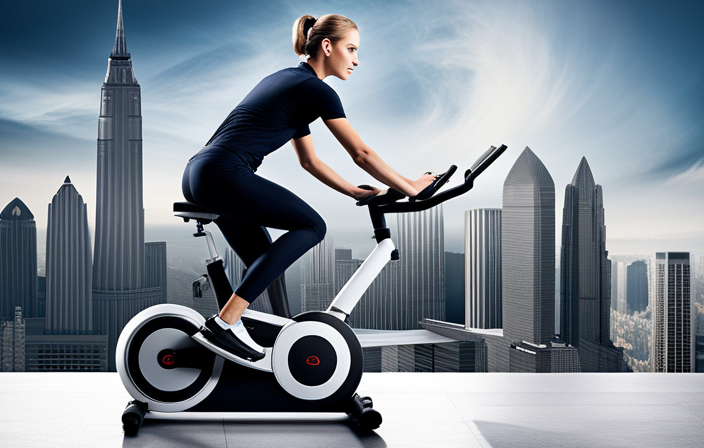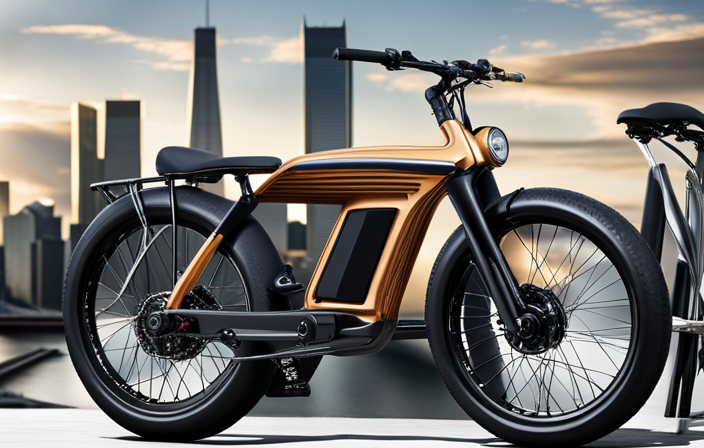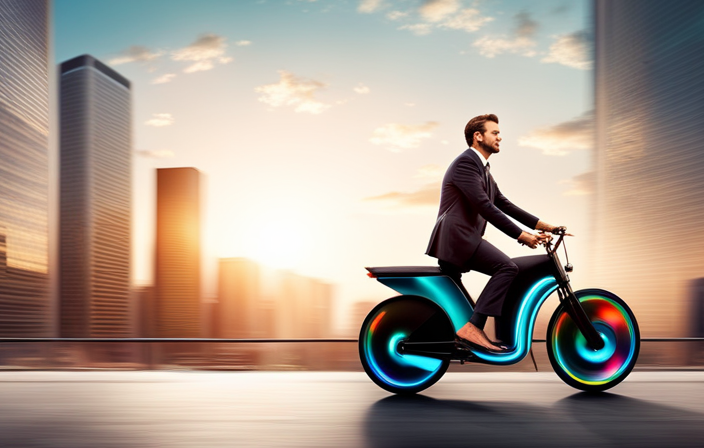As an avid cyclist, I’ve always been on the lookout for the perfect electric bike, one that truly ignites my passion for riding. So, like a detective in pursuit of the ultimate two-wheeled companion, I set out to uncover the crème de la crème.
In this article, I’ll guide you through the maze of options, exploring the types of electric bikes, considering your riding needs, and diving into the nitty-gritty of motor and battery features.
Get ready to zip through the streets and conquer any terrain with the best electric bike for you.
Key Takeaways
- There are three main types of electric bikes: hub motors, mid-drive motors, and friction drive motors, each with their own advantages and disadvantages.
- When choosing an electric bike, it is important to consider factors such as distance and terrain, speed and power, battery range, weight capacity, budget, and motor and battery features.
- Motor power and torque, battery capacity and charging time, and the option of removable or non-removable batteries are important factors to consider when looking at motor and battery features.
- The frame material, suspension type, and comfort and riding experience are key factors to consider when looking at the frame and suspension of an electric bike.
Types of Electric Bikes
There’s a wide range of options when it comes to the types of electric bikes available. One of the key factors to consider is the type of electric bike motor. There are three main types: hub motors, mid-drive motors, and friction drive motors.
Hub motors are the most common and are located in either the front or rear wheel, providing a smooth and quiet ride. Mid-drive motors are situated near the pedals, giving a more balanced weight distribution and better handling. Friction drive motors are less common and attach to the side of the tire, providing a lightweight and affordable option.
The advantages of electric bikes are numerous. They offer a convenient and eco-friendly mode of transportation, increase your range and speed, and provide assistance when needed. Considering your riding needs, such as terrain and distance, will help you choose the perfect electric bike for you.
Consider Your Riding Needs
When it comes to choosing an electric bike, there are several key factors to consider.
First and foremost, think about the distance and terrain you’ll be riding on. Are you planning on tackling hilly terrains or primarily riding on flat roads?
Next, consider the speed and power you’ll need. Do you want a bike that can reach high speeds or do you prefer a more leisurely pace?
Additionally, battery range and weight capacity are crucial factors to take into account. How far do you need to go on a single charge, and will the bike be able to handle your weight and any additional cargo?
Distance and Terrain
The most important factor to consider when choosing the best electric bike is how far and over what type of terrain you will be riding. The distance you need to cover and the terrain you plan to conquer will determine the features you should prioritize in an electric bike.
Here are some key considerations:
-
Longest Range:
-
Look for a bike with a high-capacity battery that can provide the longest range possible.
-
Consider bikes with efficient motor systems that optimize battery usage to maximize your riding distance.
-
Steep Hills:
-
Seek a bike with a powerful motor that can handle steep inclines effortlessly.
-
Choose a bike with multiple levels of pedal assist or a throttle option to help you conquer those challenging hills.
Considering these factors will ensure that your electric bike can take you the distance and conquer any terrain you encounter.
Now, let’s delve into the next section about the speed and power of electric bikes.
Speed and Power
To maximize your riding experience, you’ll want to prioritize finding an electric bike with impressive speed and power capabilities. When it comes to electric bikes, the motor power and battery range are crucial factors to consider. A powerful motor ensures that you can reach higher speeds effortlessly, providing an exhilarating riding experience. Additionally, a bike with a long battery range allows you to ride for extended periods without worrying about running out of power. To help you visualize the importance of speed and power, take a look at the table below:
| Electric Bike | Motor Power (Watts) | Max Speed (mph) |
|---|---|---|
| Bike A | 500 | 20 |
| Bike B | 750 | 25 |
| Bike C | 1000 | 30 |
| Bike D | 1500 | 35 |
As you can see, the motor power directly correlates with the maximum speed. So, if you’re looking for a thrilling ride, consider opting for a bike with higher motor power. Now, let’s dive into the next section and explore the importance of battery range.
Battery Range
If you want to ride for extended periods without worrying about running out of power, you’ll need a bike with a long battery range. Having a bike with a good battery life is crucial, especially if you enjoy long rides or need to commute long distances. Here are some reasons why battery range is important:
- Peace of mind: A long battery range means you can ride for hours without the fear of suddenly running out of power.
- Flexibility: With a longer battery range, you have more freedom to explore different routes and take detours without having to constantly think about recharging.
- Charging infrastructure: As the popularity of electric bikes grows, the charging infrastructure is also expanding. Many cities now have dedicated charging stations, making it easier to find a place to recharge your bike.
With the right battery range, you can fully enjoy the benefits of an electric bike without any limitations.
Speaking of limitations, another important aspect to consider is the weight capacity.
Weight Capacity
When considering weight capacity, you’ll want to make sure your bike can support your weight and any additional cargo you may be carrying. It’s important to understand the weight capacity of your electric bike, as exceeding this limit can have detrimental effects on the performance and longevity of your bike. To help you make an informed decision, I’ve created a table below showcasing the weight capacity and frame durability of some popular electric bike models:
| Electric Bike Model | Weight Capacity (lbs) | Frame Durability |
|---|---|---|
| Model A | 250 | High |
| Model B | 300 | Medium |
| Model C | 350 | High |
| Model D | 400 | Low |
| Model E | 450 | Medium |
As you can see, the weight capacity varies across different models, and it’s crucial to choose a bike that can handle your weight and any additional cargo you may need to carry. Frame durability is also an important factor to consider, as it determines the overall strength and longevity of your bike. Now that you have an understanding of weight capacity and frame durability, let’s move on to the next aspect to consider – budget considerations – to help you find the best electric bike for your needs.
Budget Considerations
One important factor to consider when choosing the best electric bike is your budget.
Not all electric bikes are created equal, and their prices can vary greatly. However, it’s important to remember that a higher price tag doesn’t always guarantee better quality.
When considering your budget, it’s important to take into account both the initial cost of the electric bike and the long-term maintenance costs. Some electric bikes may have higher maintenance costs due to complex components or specialized parts.
Additionally, consider the portability options offered by different electric bikes. If you plan on transporting your bike frequently, look for models that are lightweight and foldable.
Now, let’s dive into the exciting world of motor and battery features.
Motor and Battery Features
When it comes to choosing an electric bike, there are several key factors to consider regarding the motor and battery features.
First and foremost, the motor power and torque are crucial in determining the bike’s performance and ability to tackle different terrains. A higher motor power will provide more speed and efficiency, while greater torque ensures better acceleration and climbing capabilities.
Additionally, the battery capacity and charging time play a significant role in determining the bike’s range and convenience. A larger battery capacity will allow for longer rides without needing to recharge, while a shorter charging time ensures minimal downtime between rides.
Lastly, the choice between removable and non-removable batteries is an important consideration. Removable batteries offer the flexibility of charging them separately, allowing for convenience and the opportunity to carry a spare battery for extended trips. On the other hand, non-removable batteries are typically integrated into the frame, providing a sleeker design and added security against theft.
Considering these factors will help you find the perfect electric bike that meets your specific needs and preferences.
Motor Power and Torque
You should consider the motor power and torque when choosing the best electric bike. These factors play a crucial role in determining the overall performance and ride quality of the bike. Motor efficiency is an important aspect to consider, as it directly affects the bike’s range and energy consumption. A more efficient motor will allow you to go further on a single charge.
Additionally, the motor power and torque determine the bike’s hill climbing ability. A powerful motor with high torque will effortlessly conquer steep inclines, making your rides more enjoyable and hassle-free. However, it’s essential to strike a balance between power and efficiency to ensure optimal performance.
Now, let’s move on to discussing another important aspect of electric bikes: battery capacity and charging time.
Battery Capacity and Charging Time
The battery capacity and charging time are key factors to consider when choosing an electric bike. The battery life determines how far you can ride on a single charge, while the charging time affects how quickly you can get back on the road. A higher battery capacity means you can go longer distances without worrying about running out of power.
Having a fast charging time is crucial, especially if you rely on your bike for daily commuting or long rides. It’s also important to consider the charging infrastructure in your area. Are there enough charging stations available? Can you easily find a place to charge your bike when needed? These factors will greatly impact the convenience and usability of your electric bike.
Now, let’s delve into the next section about removable vs non-removable batteries.
Removable vs Non-Removable Batteries
Having a removable battery offers more flexibility and convenience for charging and maintenance. With a removable battery, I can easily swap out a depleted battery for a fully charged one, allowing me to continue my ride without having to wait for the battery to charge. Additionally, it gives me the freedom to charge the battery wherever is most convenient for me, whether it’s at home, work, or a charging station.
- Easy battery replacement
- Portable charging options
- Longer lifespan for the bike
On the other hand, non-removable batteries have some drawbacks. They often require the entire bike to be brought to a charging station, which can be inconvenient and time-consuming. Additionally, if the battery malfunctions or loses its capacity over time, it may require professional assistance to replace or repair it, adding to the overall cost and hassle.
Transitioning into the subsequent section about the ‘frame and suspension’, the design of the bike plays a crucial role in its overall performance and comfort.
Frame and Suspension
When it comes to choosing the best electric bike, there are several key factors to consider.
Firstly, the frame material is an important consideration. The frame material determines the bike’s durability and weight. There are various options available, ranging from aluminum to carbon fiber. Each material has its own advantages and disadvantages, so it’s important to choose one that suits your needs and preferences.
Another important factor to consider is the suspension type. The suspension type plays a significant role in absorbing bumps and providing a smooth ride. There are two main types of suspension: front suspension fork and full suspension system. Each type has its own benefits, so it’s important to choose one that suits the terrain you’ll be riding on.
Comfort and riding experience are also key factors to consider. These factors go hand in hand, as they can greatly enhance or detract from your enjoyment on the bike. Factors such as seat design, handlebar position, and overall ergonomics can make a big difference in how comfortable and enjoyable your ride is.
Frame Material
Choosing the right frame material for your electric bike can greatly impact its performance and durability. When it comes to bike durability, there are a few frame materials that stand out – aluminum, carbon fiber, and steel.
Aluminum frames are lightweight, stiff, and corrosion-resistant, making them a popular choice for electric bikes. Carbon fiber frames offer even greater weight savings and stiffness, but they can be more expensive. Steel frames, on the other hand, are known for their strength and durability, but they tend to be heavier.
When it comes to performance comparison, aluminum and carbon fiber frames offer better power transfer and responsiveness, while steel frames provide a smoother and more comfortable ride.
Now, let’s move on to the next section and discuss the importance of suspension type.
Suspension Type
When it comes to electric bikes, the frame material plays a crucial role in determining the overall performance and durability of the bike. Another important aspect that greatly affects the comfort and riding experience is the suspension type.
The suspension system of an electric bike is responsible for absorbing shocks and vibrations from uneven terrains, providing a smoother and more enjoyable ride. There are various suspension types available, such as front suspension, rear suspension, or full suspension.
Front suspension, also known as a hardtail, offers improved shock absorption at the front wheel, while rear suspension provides enhanced comfort at the back wheel. On the other hand, full suspension bikes offer the highest level of comfort and control by incorporating both front and rear suspension.
Now that we have discussed the importance of frame material and suspension type, let’s delve into the next section about the comfort and riding experience.
Comfort and Riding Experience
The suspension type greatly impacts the comfort and riding experience of an electric bike. When choosing an electric bike, it’s important to consider how the suspension will affect your overall comfort and performance. A well-designed suspension system can absorb bumps and vibrations, providing a smoother and more enjoyable ride. On the other hand, a stiff suspension may prioritize performance but sacrifice comfort. It’s a delicate balance between these two factors.
To help you make an informed decision, here is a comparison table showcasing the different suspension types commonly found in electric bikes:
| Suspension Type | Comfort | Performance |
|---|---|---|
| Front | Moderate | Good |
| Full | Excellent | Excellent |
| Hardtail | Limited | Good |
By understanding the trade-offs between comfort and performance, you can choose the suspension type that best suits your riding style and preferences. It’s also worth noting that electric bikes offer a more eco-friendly transportation option compared to traditional vehicles, reducing our impact on the environment. With the right suspension, you can enjoy both a comfortable ride and contribute to a greener future.
Next, let’s explore the additional features that can further enhance your electric bike experience.
Additional Features
You’ll love the additional features on these electric bikes. They are designed with the latest bike accessories and smart features to enhance your riding experience. Here are some of the standout features:
- Integrated GPS: Never get lost again with built-in GPS navigation that guides you on your route.
- Smartphone Connectivity: Connect your phone to the bike’s interface and access important information like battery life and speed.
- LED Lighting: Stay visible and safe on the road with powerful LED lights that illuminate your surroundings.
These additional features not only make your electric bike more convenient and user-friendly but also add an extra layer of enjoyment to your rides.
Now, let’s move on to the next section and explore the importance of test rides and reviews in helping you find the perfect electric bike for your needs.
Test Rides and Reviews
To determine the ideal electric bicycle for you, try taking test rides and reading reviews from other riders. There’s no better way to truly understand the performance and feel of an electric bike than by experiencing it firsthand.
During a test ride, pay attention to the acceleration, handling, and comfort. Take note of how the electric motor assists you and whether it feels smooth and responsive.
It’s also important to consider the range and battery life, as well as the overall build quality and design.
Reading customer reviews can provide valuable insight into the long-term reliability and satisfaction of the bike. By combining your test ride experience with the feedback from other riders, you can make a well-informed decision.
Now, let’s move on to the next section and explore considerations for commuters.
Considerations for Commuters
When it comes to choosing an electric bike for commuting, there are a few key considerations that can greatly impact your overall experience.
First and foremost, portability and storage are crucial factors to keep in mind. A compact and lightweight electric bike will make it easier to carry and store, especially if you have limited space in your home or office.
Secondly, considering your commuting distance and desired speed is essential for finding the right electric bike. Whether you have a short commute or a longer one, having a bike that can handle the distance and reach your desired speed will ensure a smoother and more efficient ride.
Lastly, safety features should never be overlooked. From reliable brakes to bright lights and reflective materials, having a bike that prioritizes safety will give you peace of mind during your daily commute.
Portability and Storage
If you’re looking for a portable and easy-to-store electric bike, consider the folding models available on the market. These bikes offer excellent portability options and storage solutions, making them ideal for those with limited space or on-the-go lifestyles.
With their innovative folding mechanisms, these bikes can be quickly and effortlessly folded down into a compact size, allowing you to easily carry them onto public transportation or store them in small apartments and offices. Some models even come with specially designed carrying cases or bags, further enhancing their portability.
Whether you need to store your bike in a tight corner or take it with you on your travels, folding electric bikes provide convenient solutions.
Now, let’s delve into the next section and explore the factors of commuting distance and speed.
Commuting Distance and Speed
After considering the portability and storage options of electric bikes, let’s now delve into another important aspect: commuting distance and speed. As someone who relies on an electric bike for my daily commute, I understand the significance of these factors. Electric bikes offer an efficient mode of transportation, allowing me to cover longer distances in a shorter time compared to traditional bikes. To illustrate this further, let’s take a look at the following table:
| Electric Bike Model | Max. Commuting Distance | Max. Speed |
|---|---|---|
| Model A | 50 miles | 20 mph |
| Model B | 40 miles | 18 mph |
| Model C | 45 miles | 22 mph |
| Model D | 55 miles | 25 mph |
Not only do electric bikes provide an efficient means of commuting, but they also have a positive impact on the environment. By opting for an electric bike, I contribute to reducing air pollution and carbon emissions, making my daily commute more eco-friendly. With the knowledge of commuting efficiency and environmental impact, let’s now explore the next section: safety features.
Safety Features
Let’s now look at the safety features of different models to determine their suitability.
One of the most important safety features to consider is the bike helmet. It is crucial to find a model that offers proper head protection and a secure fit. Look for helmets that meet safety standards and have adjustable straps for a personalized fit.
Another key safety feature to consider is the braking system. A reliable braking system is essential to ensure quick and effective stopping power. Look for models that have hydraulic disc brakes or high-quality mechanical brakes. These provide excellent stopping power and control, particularly in emergency situations.
Taking these safety features into account will help to ensure a safe and enjoyable riding experience.
Now, let’s discuss considerations for off-road enthusiasts.
Considerations for Off-Road Enthusiasts
When choosing an electric bike for off-road adventures, it’s important to consider factors such as suspension, tire traction, and battery life. These key elements can greatly enhance your riding experience and ensure a smooth and enjoyable journey.
-
Suspension: Opt for a bike with a high-quality suspension system that can handle rough terrains and absorb shocks effectively. This will provide better control and comfort during your off-road rides.
-
Tire Traction: Look for electric bikes with wide and knobby tires to maximize traction on uneven surfaces. This will improve your grip and stability, allowing you to navigate through challenging trails with ease.
-
Battery Life: Off-road adventures can be demanding, so choose an electric bike with a long-lasting battery. Ensure that it can provide sufficient power to support your entire journey, allowing you to explore without worrying about running out of battery.
To fully prepare for your off-road escapades, don’t forget to invest in proper riding gear and follow maintenance tips to keep your electric bike in top shape.
Now, let’s move on to the final decision and purchase.
Final Decision and Purchase
To make your final decision and purchase, consider all the factors discussed to ensure a smooth and enjoyable off-road experience.
When choosing an electric bike, it’s important to determine whether you’ll be using it primarily for commuting or recreational purposes. Commuter bikes are designed for efficiency, with features like fenders, racks, and lights, while recreational bikes are built for fun and adventure, with features like suspension and larger tires.
Another factor to consider is whether you want a folding or traditional electric bike. Folding bikes are great for those who need to save space or travel frequently, while traditional bikes offer a more stable and sturdy ride.
Ultimately, the decision comes down to your personal preferences and needs. So take your time, test ride different models, and choose the electric bike that will bring you the most joy on your off-road adventures.
Frequently Asked Questions
How long does it take to fully charge the battery of an electric bike?
It usually takes around 2 to 6 hours to fully charge the battery of an electric bike, depending on the battery capacity. The charging time can vary, but it’s essential to charge it fully for optimal performance and longer rides.
Are electric bikes legal to ride on public roads?
Yes, electric bikes are legal to ride on public roads in many countries, including the US and UK. Electric bike regulations vary, but generally, they have the same rights and responsibilities as regular bicycles. Riding electric bikes offers numerous benefits, such as reducing carbon emissions and improving personal health.
Can I use an electric bike for long-distance rides?
Yes, you can definitely use an electric bike for long-distance rides. The weight of the electric bike is a crucial factor to consider, as lighter bikes provide greater maneuverability. The benefits of using an electric bike for long distances include reduced fatigue, extended range, and the ability to conquer challenging terrains with ease.
Are there any specific maintenance requirements for electric bikes?
Maintenance tips for electric bikes include regularly checking the tires, brakes, and battery. Common issues to watch out for are loose connections, worn-out brake pads, and battery degradation. Proper maintenance ensures optimal performance and extends the lifespan of your electric bike.
What is the average lifespan of an electric bike battery?
The average lifespan of an electric bike battery can vary depending on several factors. These include the average battery capacity, usage patterns, charging habits, and overall maintenance. Taking good care of your battery can help extend its lifespan and ensure optimal performance.
Conclusion
After carefully considering all the factors, it is clear that choosing the best electric bike is a personal decision. It depends on your riding needs, budget, and preferences.
Whether you are a commuter or an off-road enthusiast, there is an electric bike out there that will suit your needs. So, don’t just take my word for it, go out and test ride some bikes, read reviews, and make an informed decision.
Remember, the proof of the pudding is in the eating. Happy riding!
















